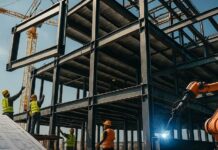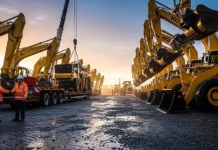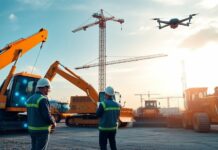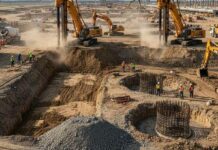In the evolving realm of architectural innovation, the boundaries when it comes to traditional and advanced materials are dissolving very fast. And a fresh design and fabrication paradigm, which is multi-material parametrics, happens to be emerging at the forefront by way of unifying diverse materials such as concrete, timber, and advanced composites within a single parametric design framework, where engineers as well as architects are unleashing unmatched possibilities when it comes to structural performance, sustainability, and aesthetics. This kind of approach is no longer an experiment but has become a luxury due to a practical response to the intricate demand of modern construction. Driven by computational design tools as well as material science advances, multi-material parametric happen to be establishing themselves as a transformative force when it comes to architecture and engineering.
The conversion, when it comes to materiality and computation
Historically, concrete, wood, and composites have gone on to serve various purposes within the built environment. Timber offered warmth and renewability, concrete gave mass and durability, and composites presented lightness and tensile strength, but their mix, however, was rarely optimized either in a practical or aesthetic way.
In today’s times, due to parametric modelling, designers can simulate as well as orchestrate the integration of these materials with utmost precision. Digital tools such as Rhino, Grasshopper, and the generative design engine from Autodesk help architects to iterate when it comes to geometry and stress distribution and act in real time. These tools help material zoning, where every section of a structure goes on to perform a specific task. For example, wood for insulation and flex, composite for tensile elements as well as joints, and concrete for compression zones. This is not just an aesthetic fusion, but it is a performance space design where form follows simulation, and every material is rolled out at its structural and environmental best.
Specific roles in hybrid assemblies of material
Concrete – which is often critiqued for its ecological footprint—becomes far more effective when used in a selective way. Parametric evaluation enables form-optimized casting, decreased volume, and waste. Ultra-high-performance concrete, which is UHPC, can be cast in thinner, more intricate shells that have embedded voids, which maximize the performance while minimizing the mass.
Wood – goes on to offer environmental credentials that are unmatched by most materials. Engineered wood products such as cross-laminated timber (CLT) as well as glutamate are being used when it comes to high-rise applications, which showcase their strength, renewability, and low carbon impact. Parametric tools enable complex milling and joinery, thereby helping wood to serve as a major support system.
Composites – like carbon fiber reinforced polymers or even glass fiber laminates—help in dynamic and tensile applications. By way of using robotic winding as well as AI assistant filament placement, designers can go ahead and integrate composite meshes, which help in binding wooden or concrete structures and at the same time remain lightweight along with being adaptive to stress shifts.
| Material | Core Strength | Ideal Function in Hybrid Structures |
| Wood (CLT, glulam) | Renewable, tensile-flexural strength | Façade, interior framing, mid-rise cores |
| Concrete (UHPC, low-carbon) | Compressive strength, moldable | Foundations, compression zones, thermal mass |
| Composites (FRP, CFRP) | High tensile strength, lightweight | Joints, tension zones, reinforcement meshes |
Computational design goes on to meet material behaviour
The effectiveness when it comes to multi-material parametrics happens to lie in the fusion of computational logic along with real-world behavior when it comes to materials. Parametric design algorithms not only generate forms but also model how these forms would go on to respond to environmental conditions, loads, and time.
For instance, when it comes to a hybrid structure in which a timber lattice spans throughout a concrete arch, designers make use of finite element analysis (FEA) in the parametric software in order to test how wind loads distribute stress throughout the different materials. Machine learning models can also go ahead and predict long-term deflections or even stress fatigue based on climate data as well as usage simulations. These kinds of insights feed directly back into design iterations. This loop, which is predicting, analyzing, and optimizing, happens to be the engine when it comes to multi-material parametric architecture.
Built instances of hybrid structures | case studies
One of the striking examples of this is the BUGA Wood Pavilion in Germany’s Heilbronn, which went on to integrate design timber shells having robotic fabrication. The concrete footings went on to support curved timber panels, which were assembled by way of interlocking joints, thereby eliminating the requirement for adhesives.
In another project, the smart slab at ETH Zürich went on to combine 3-D printed formwork when it came to a concrete slab with CFRP reinforcement as well as CLT supports. Every material was ruled out for optimal performance, which was then guided by generative design.
These projects go on to demonstrate that hybrid parametric structures don’t happen to be futuristic concepts. They are buildable realities that are grounded in rough material science and helped by computation.
| Performance Metric | Timber | Concrete | Composites | Multi-Material Hybrid |
| Structural Adaptability | Moderate | Low | High | Very High |
| Carbon Footprint | Low | High | Moderate | Low to Moderate |
| Customization Potential | High | Medium | High | Very High |
| Durability (lifecycle) | Medium | High | High | Optimized |
| Construction Waste | Low | Moderate | Low | Minimized through design |
Future market prediction when it comes to the multi-material parametrics market—2024 to 2032
As per the 2024 global construction innovation forecast, the multi-material parametrics market is all set to grow at a CAGR of 9.3% all through 2032, and it’s going to be driven due to the alignment with sustainable construction, smart cities, as well as advanced robotics.
There would be major investments that would be flowing into start-ups as well as research institutes by developing fabrication systems when it comes to hybrid construction. The combination of decreased material use, increased construction times, as well as climate aligned performance is indeed drawing attention when it comes to both private developers as well as public infrastructure agencies.
| Year | Estimated Market Value (USD Billion) |
| 2024 | 4.1 |
| 2026 | 5.4 |
| 2028 | 7.1 |
| 2030 | 8.9 |
| 2032 | 10.7 |
Drivers which push the market growth
- Sustainability mandates – regulatory pressure along with voluntary commitments—are indeed driving demand when it comes to low-carbon materials as well as efficient construction strategies. Multi-material hybrids are going to help in reducing embodied energy by way of targeted material usage and offer superior life-cycle sustainability.
- Advancements in robotic fabrication – 3-D printing, robotic arms, and filament winding—happen to be revolutionizing how intricate hybrid geometries are built. These technologies go on to support seamless assembly when it comes to multiple materials having high precision as well as repeatability.
- Designed tools which are AI-driven – and parametric, along with generative design software integrated with AI, help with real-time optimization when it comes to load paths, material allocation, and energy performance, thereby drastically eradicating design time while at the same time boosting performance.
- Circular construction objectives – It is well to be noted that hybrid parametric systems enable selective disassembly as well as reuse of materials, thereby supporting cradle-to-cradle construction philosophy. This is especially appealing when it comes to urban retrofit as well as modular architecture.
Hurdles when it comes to mainstream adoption
- Material compatibility along with jointing Intricacy – It is worth noting that different materials have varied expansion coefficients, structural tolerances, as well as moisture behaviours. Designing joints which go on to handle these differences needs interdisciplinary knowledge as well as advanced simulation.
- Dearth of building code alignment – The existing construction codes happen to be largely written for single-material systems. Hybrid designs often go on to face regulatory barriers or need costly custom nods.
- Cost as well as fabrication accessibility – Advanced fabrication tools as well as custom multi-material setups are very capital intensive. Smaller firms or projects that have limited budgets go on to struggle in order to justify investment.
- Knowledge gaps across the stakeholders – Effective execution needs collaboration among engineers, architects, software specialists, and fabricators. This kind of integration is often not seen when it comes to traditional project delivery methods.
Marching towards a new architectural intelligence
The growth of multi-material parametrics goes on to signify a profound transition in how we conceive, construct, and design our built environment. It also reflects a maturing when it comes to both technological capabilities as well as ecological consciousness, which is a moment where material innovation, sustainability, and computational intelligence converge.
It is worth noting that no longer are wood, composites, and concretes in different realms of usage; instead, they are becoming collaborators when it comes to symphony and structural dialogue – each playing its own role and strength, each contributing to overall performance. Parametric design doesn’t just enable this kind of intricacy; it sort of thrives on it. By way of data-driven simulation as well as performance modeling, one can now choreograph how the materials would interact, behave, and even evolve with time.
This is indeed the paradigm of intelligence where buildings are not only static masses, but they are responsive systems. Multimeter parametrics brings us much closer to the ideals of designing with the grain of the material, only that the grain is not just wood, but now it is thermal behavior, tensile flow, lifestyle, adaptability, and carbon footprint, as well as lifecycle adaptability.
The potential is indeed transformative
- Resilient structures that go on to adapt to loads, climate, and use patterns.
- Sustainable construction by way of precision as well as minimal waste.
- Architecture that’s expressive and goes on to reflect its structural logic as well as material honesty.
However, realizing this kind of potential needs a new culture of partnership between disciplines and digital tools as well as manual craft and between traditions along with innovation. Architects must definitely think like material scientists, and the engineers have to speak the language of generative algorithms. On the other hand, builders must engage with the robotic systems.
The future of design lies in these conversions
As we march forward, multi-material parametrics isn’t just a tool set, but it is a philosophy of making. One that is at once computational as well as human, technical along with being artistic, and grounded as well as visionary. It indeed challenges us to witness materials, not just as building blocks, but as opportunities when it comes to expression, efficiency, and, of course, ecological intelligence. In an era that is defined by way of urban density, climate urgency, and digital speed, this is the kind of architecture that one needs– sustainable, smart, as well as deeply material. We are just beginning to unearth what is possible when matter meets machine and when craft meets the code. And in the future, it is indeed hybrid, it is parametric, and it is stunningly complex.
































